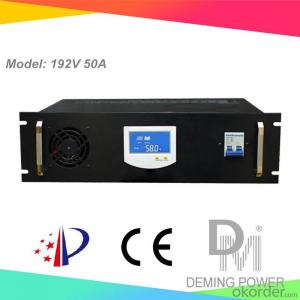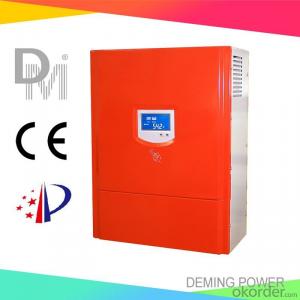MPPT Solar Charge Controller 192V 50A for off grid solar power system and RS485 available
- Loading Port:
- Qingdao
- Payment Terms:
- TT OR LC
- Min Order Qty:
- 1 PCS
- Supply Capability:
- 1000 PCS/month
OKorder Service Pledge
OKorder Financial Service
You Might Also Like
Properties of the solar charge controller
1. Design for off-grid solar power system.
2. Applicable to different kinds of batteries.
3. Adopts MPPT technology (Maximum Power Point Tracking). The advanced tracking algorithm make the solar module operate at ideal voltage which the solar modules can produce the maximum available power.
4. Modular design with simple structure and easy maintenance.
5. Automatic power control function.
6. LCD display: Solar panel current, solar panel voltage, solar panel power, battery group voltage, charge current.
7. Perfect protection function: Solar reverse charge protection, Solar reverse connection protection, Battery reverse connection protection, Battery overcharge protection, Battery over current protection etc ,thus the system has higher reliability.
Technical parameters of the solar charge controller
Model | 192V50A | ||
Battery group rated voltage | 192Vdc | ||
PV Rated current | 50A | ||
PV open circuit voltage | 500V | ||
PV Max. power | 9600Wp | ||
MPPT input DC voltage range | 150-240Vdc | ||
Input PV module road number | 1 | ||
Function | MPPT charge mode, auto stop charge, auto recharge voltage; Protection: connecting contrary, over current, short circuit, over heat etc. | ||
Display mode | LCD | ||
Display content | solar panel voltage, solar panel current, solar panel power, battery voltage, charge current | ||
Floating Charge Voltage (adjustable) | 110Vdc | ||
Stop charge voltage | 116Vdc±1% | ||
Recharge voltage | 108V±1% | ||
Voltage drop between PV and battery | 1.5V | ||
Max itself power consumption | 100mA-150mA | ||
Work environment temperature | -30-60°C | ||
Relative humidity | 90% No condensation | ||
Applicable altitude | 3000m The rated power should be reduced when it is higher than 2000m | ||
Noise (1m) | 40dB | ||
Degree of protection | IP20(Indoor) | ||
Cooling method | Forced air cooling | ||
*Communication interface (optional) | RS485/USB | ||
*Temperature compensation(optional) | -4mv/°C/2V,-35°C~+80°C,Accuracy:±1°C | ||
Product size (mm) | 520*430*200mm, (Black one) 480*360*150mm, (Red one) | ||
Weight(kg) | 12Kg(Black one) 14kg(Red one) | ||
*Above parameter only for reference. Could be custom made to user specifications.
- Q:Can a PWM solar controller be used with an MPPT solar panel?
- No, a PWM solar controller cannot be used with an MPPT solar panel. These two technologies are not compatible as they have different operating principles. PWM (Pulse Width Modulation) solar controllers regulate the voltage output from the solar panel by rapidly switching the panel's current on and off, resulting in a fixed voltage output. On the other hand, MPPT (Maximum Power Point Tracking) solar panels utilize advanced electronics to optimize the power output by continuously adjusting the voltage and current levels to extract maximum energy from the solar panel. Therefore, to maximize the efficiency and performance, it is recommended to use an MPPT solar controller with an MPPT solar panel.
- Q:Can a solar controller be used in a solar-powered interplanetary travel system?
- Yes, a solar controller can be used in a solar-powered interplanetary travel system. A solar controller is responsible for regulating and optimizing the charging and discharging of batteries within a solar power system. In an interplanetary travel system, solar panels would be used to harness the energy of the sun, and a solar controller would be essential to manage the power flow, ensure efficient energy storage, and protect the batteries from overcharging or discharging.
- Q:What is the maximum load wattage a solar controller can handle?
- The maximum load wattage a solar controller can handle depends on the specific model and its specifications. It can vary widely, ranging from a few hundred watts to several kilowatts. It is important to check the manufacturer's guidelines and specifications for the particular solar controller in order to determine its maximum load wattage capacity.
- Q:What is the maximum voltage drop allowed between the solar panels and the batteries?
- Several factors determine the maximum allowable voltage drop between the solar panels and the batteries. These factors include the battery type and capacity, the distance separating the panels and batteries, and the efficiency of the charging system. To ensure efficient charging and minimize energy loss, it is generally advised to maintain a low voltage drop. A widely accepted guideline suggests limiting the voltage drop to approximately 3% to 5% of the total system voltage. For instance, if the batteries are rated at 12V and the solar panels are connected in a 24V system, the maximum voltage drop should range from 0.36V to 0.6V (3% to 5% of 12V). To achieve this, it is crucial to employ adequately sized wires with minimal resistance, reduce the distance between the panels and batteries, and consider the utilization of voltage regulators or charge controllers to optimize the charging process. To ensure the voltage drop remains within the recommended limits, it is vital to consult the guidelines and specifications provided by the manufacturers of both the solar panels and batteries.
- Q:How do you prevent over-discharging of batteries with a solar controller?
- To prevent over-discharging of batteries with a solar controller, a key strategy is to set a low voltage disconnect (LVD) threshold on the controller. This threshold ensures that the battery is disconnected from the load when the voltage drops to a level that could potentially damage the battery. By disconnecting the load at this point, the battery is protected from over-discharging, thereby extending its lifespan and maintaining optimal performance. Additionally, some solar controllers offer features such as battery voltage monitoring and alarms to provide early warnings and prevent over-discharging.
- Q:How does a solar controller protect the batteries from over-discharging?
- The batteries in a solar power system are safeguarded against over-discharging by a solar controller. This controller continuously monitors the state of charge (SOC) of the batteries and regulates the flow of energy between the solar panels and the batteries. As soon as the SOC reaches a specific low threshold, the controller will automatically disconnect the batteries from the charging source, thus preventing any further discharge. By cutting off the power supply at the appropriate moment, the controller ensures that the batteries are not depleted beyond their safe limits. This is crucial as surpassing these limits can result in irreversible damage to the batteries and reduce their lifespan. Therefore, this feature plays a vital role in maintaining the health and longevity of the batteries within a solar power system.
- Q:How does a solar controller handle battery low voltage protection?
- A solar controller handles battery low voltage protection by continuously monitoring the voltage level of the battery. When the voltage drops below a certain threshold, typically around 11.5 to 11.8 volts, the controller activates a low voltage disconnect (LVD) feature. This feature automatically disconnects the load from the battery to prevent it from further draining and potentially damaging the battery. Once the battery voltage increases to a safe level, the controller will reconnect the load to resume normal operation.
- Q:Can a solar controller be used with solar-powered electric vehicle charging stations?
- Yes, a solar controller can be used with solar-powered electric vehicle charging stations. A solar controller is designed to regulate the flow of electricity from solar panels to the charging station, ensuring optimal charging efficiency and preventing overcharging or damage to the battery. It helps manage the power generated by the solar panels and directs it towards charging electric vehicles, making it an essential component for solar-powered charging stations.
- Q:What is the role of a battery voltage sensor in a solar controller?
- The role of a battery voltage sensor in a solar controller is to monitor the voltage level of the battery connected to the solar system. This sensor helps ensure that the battery is charged and maintained within safe operating limits by providing accurate information about its state of charge. It allows the solar controller to regulate the charging process efficiently, preventing overcharging or undercharging of the battery, which can lead to reduced battery life or system failure. Overall, the battery voltage sensor plays a crucial role in optimizing the performance and lifespan of the battery in a solar system.
- Q:What is the maximum load capacity that a solar controller can handle?
- The maximum load capacity that a solar controller can handle depends on its make and model. The load capacity is typically specified by the manufacturer and can vary greatly. It is important to consult the product specifications or contact the manufacturer for accurate information regarding the maximum load capacity of a specific solar controller.
1. Manufacturer Overview |
|
|---|---|
| Location | |
| Year Established | |
| Annual Output Value | |
| Main Markets | |
| Company Certifications | |
2. Manufacturer Certificates |
|
|---|---|
| a) Certification Name | |
| Range | |
| Reference | |
| Validity Period | |
3. Manufacturer Capability |
|
|---|---|
| a)Trade Capacity | |
| Nearest Port | |
| Export Percentage | |
| No.of Employees in Trade Department | |
| Language Spoken: | |
| b)Factory Information | |
| Factory Size: | |
| No. of Production Lines | |
| Contract Manufacturing | |
| Product Price Range | |
Send your message to us
MPPT Solar Charge Controller 192V 50A for off grid solar power system and RS485 available
- Loading Port:
- Qingdao
- Payment Terms:
- TT OR LC
- Min Order Qty:
- 1 PCS
- Supply Capability:
- 1000 PCS/month
OKorder Service Pledge
OKorder Financial Service
Similar products
New products
Hot products
Hot Searches
Related keywords

































